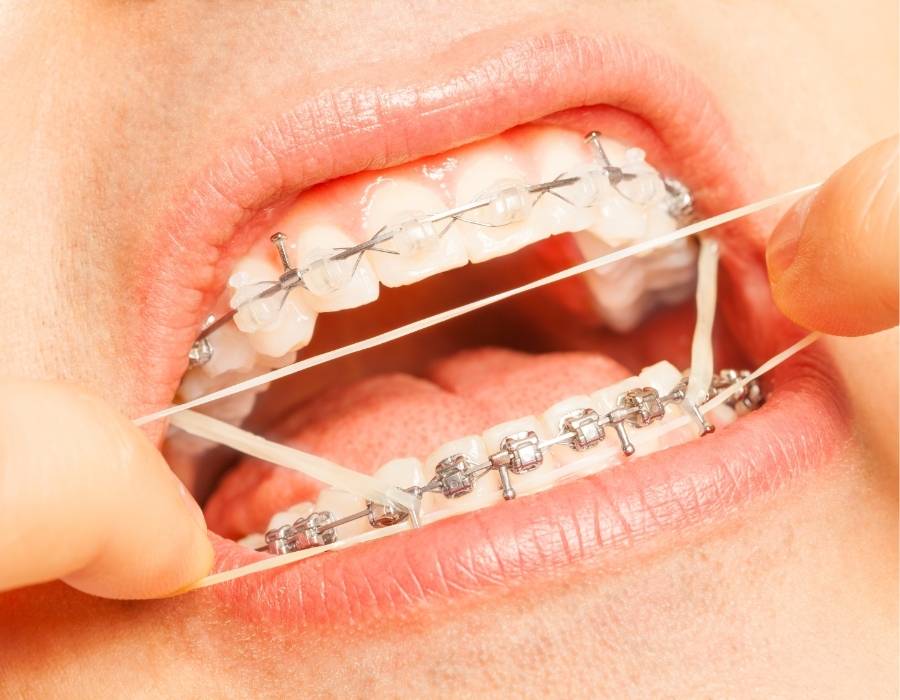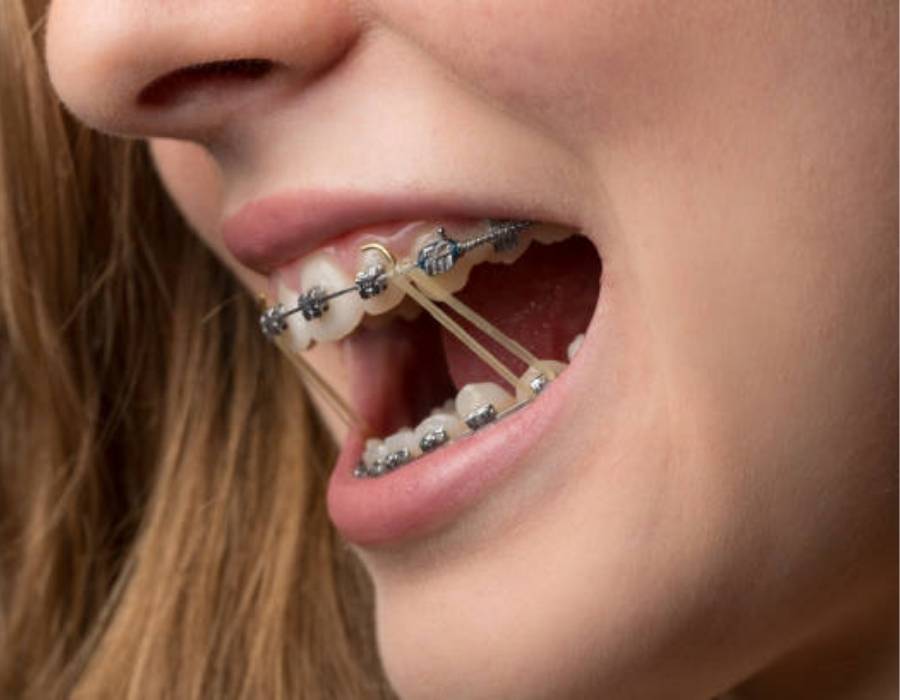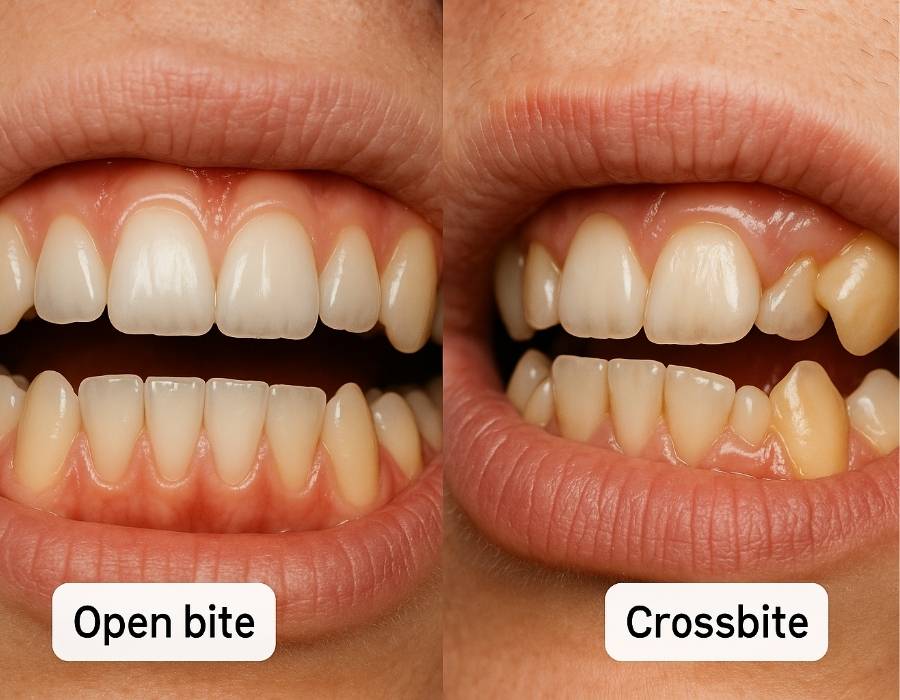Orthodontic issues like crossbites and open bites aren’t just cosmetic concerns—they can affect everything from chewing and speech to jaw health and confidence. While traditional braces and aligners help straighten teeth, not all bites are created equal. Each bite issue demands a tailored approach, especially when dealing with complex conditions like crossbites and open bites.
In this blog, we’ll explore the most common types of these bite issues, explain why personalized treatment is critical, and reveal how modern custom braces technology ensures better, faster, and more comfortable results.
Understanding Crossbite and Open Bite
What is a Crossbite?
A crossbite is a type of dental malocclusion in which one or more upper teeth bite inside the lower teeth—instead of slightly overlapping them as in a normal bite. This misalignment can affect the front teeth (anterior crossbite) or the back teeth (posterior crossbite), and it may occur on just one side (unilateral) or both sides (bilateral) of the mouth. An anterior crossbite is sometimes mistaken for an underbite but typically involves isolated front teeth or segments, whereas posterior crossbites more commonly result from narrow upper jaw arches and can trigger functional shifts of the mandible.
What is an Open Bite?
A dental open bite is a form of malocclusion where the upper and lower teeth—most commonly the front incisors—do not make contact when the mouth is closed, creating a visible gap even at full jaw closure. This condition can be anterior (front teeth) or posterior (back teeth) in nature, and may stem from prolonged habits such as thumb-sucking, tongue thrusting, or mouth breathing—or from skeletal factors, such as uneven jaw development influenced by genetics. Open bites frequently impair function and aesthetics, leading to speech issues (like a lisp), difficulty biting or chewing, uneven tooth wear, TMJ strain, and even gum recession over time.
Types of Crossbite and Open Bite You Should Know
1. Anterior Crossbite
This condition affects the upper front teeth, which bite behind the lower incisors—often misidentified as an underbite, but typically limited to specific front teeth rather than the entire jaw alignment. It can lead to accelerated wear, chipping, or recession of those teeth if untreated. Early correction typically delivers better aesthetic and functional results and prevents long-term enamel damage.
Posterior Crossbite
This involves the premolars or molars, where upper back teeth occlude inside the lower back teeth. If left untreated, it can trigger jaw asymmetry, cause functional shifts in the bite, and impair efficient chewing—especially when unilateral. Early expansion of the upper arch often resolves the issue and helps restore balanced growth.
3. Dental Crossbite
Here, the problem stems solely from tooth positioning—not jaw anatomy—often due to crowding or abnormal eruption of individual teeth. Despite normal jaw proportions, misaligned teeth cause the upper arch to intersect abnormally with the lower arch. Treatment is typically accomplished with local tooth movement using braces or light removable appliances.
4. Skeletal Crossbite
This form is rooted in discrepancies in jaw development, such as a small upper jaw or overgrown lower jaw that misaligns arches. It often requires more complex intervention—such as palate expanders, growth modification appliances, or even surgery—to correct skeletal discrepancies. Diagnostics like cephalometric X-rays help distinguish these cases and inform appropriate planning.
5. Unilateral Crossbite
A unilateral crossbite impacts only one side of the mouth, causing a lateral shift of the jaw toward the affected side and risking uneven facial growth or asymmetry. These functional shifts can lead to imbalanced muscle and joint loading, making early correction important to prevent long-term TMJ and skeletal issues.
6. Anterior Open Bite
In this type, the front upper and lower teeth fail to make contact when biting down, leaving a visible gap. It’s often caused by prolonged thumb-sucking, tongue thrusting, or skeletal jaw development issues. Functionally, it may impair biting and speech (such as a lisp) and typically requires habit intervention and orthodontic alignment to correct.
7. Posterior Open Bite
This less common form involves the back molars or premolars, which do not touch when the mouth closes, even if front teeth appear aligned. Though rare, posterior open bites can lead to inefficient chewing, jaw muscle strain, and poor digestion over time. Since these bites often involve segmental eruption issues or skeletal discrepancies, targeted orthodontic treatment is usually needed.
Tailored Approaches for Each Case

Anterior Crossbite Fixes
Correcting an anterior crossbite often begins with clear aligners or braces, sometimes enhanced with rubber elastics to gently reposition the upper incisors forward into proper alignment. When tongue thrusting is the underlying cause, adding a tongue crib appliance interrupts the habit and prevents relapse by retraining tongue placement. Interproximal reduction (IPR)—selectively removing a small amount of enamel between teeth—may also be integrated into aligner therapy to create space and facilitate movement without extractions.
Posterior Crossbite Strategies
In children and adolescents, palatal expanders—such as rapid or slow maxillary expansion appliances—are the preferred method to widen a narrow upper jaw and resolve posterior crossbites during growth. For adults whose palatal sutures have fused, surgically assisted expansion (SARPE) is required before traditional expansion can take effect, allowing skeletal correction even after growth is complete. In milder or aesthetic-focused cases, lingual braces—placed behind the teeth—offer discreet correction while influencing posterior alignment and occlusion.
Dental vs. Skeletal Solutions
When the crossbite originates from dental misalignment only—with normal jaw structure—traditional treatment with braces or clear aligners can effectively reposition teeth without addressing bone structure. In contrast, skeletal crossbites stem from jaw discrepancies, such as narrow maxilla or overgrown mandible, and often require a combination of orthodontics and jaw surgery to realign underlying bone structure for stable, functional results.
Open Bite Treatment Plans
For anterior open bites, treatment typically combines habit correction—often with a tongue crib or behavior therapy—with braces or aligners to bring front teeth into contact and restore vertical overla. Posterior open bites, although rarer, can involve appliances like bite blocks (spring-loaded or magnetic) and elastics designed to intrude or promote eruption of back teeth for improved occlusion and chewing efficiency. Treatment choice hinges on whether the open bite is primarily dental, functional, or skeletal, with more complex or skeletal cases potentially requiring orthognathic surgery for long-term stability.
Why Custom Braces Make a Difference

Custom braces redefine orthodontic care by delivering truly patient-specific treatment plans. Leveraging high-resolution 3D scans and CBCT imaging, orthodontists can map every tooth in exquisite detail, then simulate precise movement using advanced digital orthodontic software—all before the first bracket is ever bonded. Built via AI‑guided treatment planning, each bracket and wire is tailored to apply optimal forces, aligning teeth with exceptional accuracy and reducing unnecessary excursions or corrections along the way. This digital workflow promotes predictable outcomes, fewer mid-course changes, and a patient experience that’s both more comfortable and transparent.
Clinically, custom braces often translate to shortened treatment times—sometimes up to 30% faster—as well as fewer adjustment appointments and improved comfort. Studies and practice reports show that these tailored systems streamline bracket placement, reduce chair time, and lower the overall burden of treatment visits (making it especially appealing for busy families). Moreover, patients report smoother, more comfortable wear thanks to smaller, discreet brackets that are 3D‑printed for better fit and hygiene, leading to better aesthetic results and higher satisfaction overall.
Let Your Bite Shine with Custom Care
Crossbites and open bites can disrupt more than your smile—they can affect your daily function, comfort, and confidence. But thanks to today’s custom braces technology, treatment is more effective, less invasive, and quicker than ever before.
By understanding your specific type of bite and choosing a personalized orthodontic solution, you set yourself up for long-lasting results—and a smile you’ll love for life.
Don’t settle for one-size-fits-all. Your bite deserves custom care.









